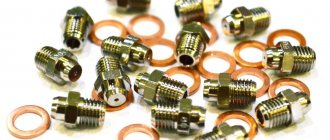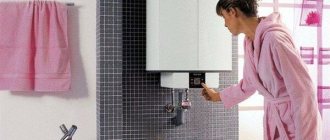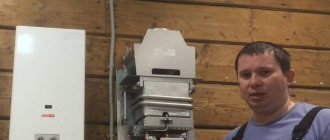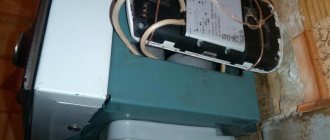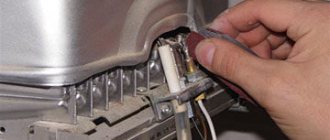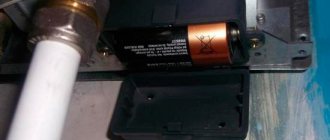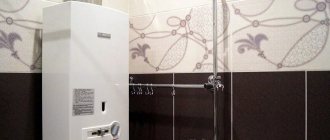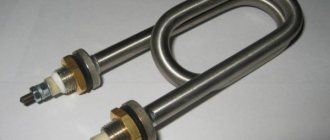20 Feb 2013, 06:40
Folks, I still have a gas water heater from my old NEVA apartment, so I want to drag it to my dacha and connect it to 4x52l gas cylinders, the gas should last for a long time, that’s 200l! The question is, is it possible to connect a gas water heater to propane-butane cylinders without contacting any authorities?
20 Feb 2013, 06:42
This can be done; in the Neva, operation from propane-butane cylinders is provided. It's not a problem. But look, if you carry out the work yourself, this is fraught, if not with a fire or explosion, then with a fine from the gas services, no small one.
So it’s better to do everything according to the law. So, of course, there will be a lot of problems with installing speakers in country houses.
Need a liquefied gas water heater
20 Feb 2013, 06:45
Hell knows, my neighbor about 4 years ago installed a column and connected it to the cylinders, so far he’s happy, nothing burned or exploded. But the gas services simply won’t let him home and everything seems to be fine with him. True, he is a former gas equipment installation specialist, but he worked in a different region.
But his hands don’t grow out of his ass, that’s for sure.
You do not have the necessary permissions to view the attachments in this message.
Alternative heating with gas from cylinders: making the right choice
If you have a boiler that runs on propane to heat your dacha, then it is very difficult to accurately determine the gas consumption it needs. Often this indicator depends on the method of insulating the room. If the winter is harsh, the figure will, of course, increase. If you have insulated your house well enough and there are no severe frosts outside, then you will use gas with great savings.
Many people prefer to heat their house with a gas boiler because it is very profitable
To calculate the approximate propane consumption for heating a room, use the formula, which shows that to obtain 1 kW of energy you will need about 0.1 kg of propane.
The fuel consumption of a gas boiler running on propane will please you much more than what you would have to pay to heat the same house using electricity. It is considered the most economical to use main gas, but it is not always possible to connect to a common centralized gas supply system. In this case, heating the room with a propane boiler will be the most sensible idea. When purchasing a heating unit, be sure to take an interest in user reviews, consult with experts, and ask consultants to give you a full description of the device and the possibility of converting it to liquefied bottled gas. Before you finally make a decision in favor of installing gas equipment, be sure to carefully weigh all the important arguments, calculate fuel consumption, and only then proceed with installation steps.
Need a liquefied gas water heater
07 May 2013, 09:48
Neva has dispensers in its lineup that run on liquefied gas. But if we are talking about used natural gas equipment that needs to be converted to another type of fuel, then doing it yourself is problematic. The burner nozzles will need to be replaced and the existing gas valve may need to be re-adjusted or replaced. This simply cannot be done without special equipment. Therefore, if it is important to transfer this particular device to another type of gas (and not buy a new one, with a ramp for liquefied gas), then in any case you need to contact a service center.
Owners of their own houses and country cottages, residents of high-rise buildings who have to deal with a central heating and hot water supply system, especially in areas where hot water is turned off for the whole summer, often encounter interruptions.
The optimal solution to the problem is a instantaneous gas water heater. Simply put, a gas water heater running on liquefied gas.
Advantages
Pros of propane water heaters:
- efficiency - cheap fuel and low cost of equipment;
- high efficiency value of the heat exchanger - reaches 88%;
- a hydraulic gas burner device is used that regulates the supply of propane - it reacts to changes in pressure;
- you can choose a modification that suits your specific requirements - a wide range of models is offered.

Which model should you choose?
It all depends on the conditions of its use:
- Speaker power. How much domestic hot water do you plan to receive per minute (and room heating)?
- Is main gas connection available?
- How will you ignite the column: automatic, manual or mini-turbine?
- Dimensions of the room where the speaker will be located: a three-dimensional structure is unlikely to fit into small-sized apartments.
- Frequent changes in water supply pressure. Some models require a certain water pressure and turn off when the pressure is low.
Of course, you need to choose from the model range of a manufacturer that has proven itself with quality products (or rely on the recommendations of friends and family).
Installation equipment
To install the heating system you will need:
- a gas boiler;
- burner for liquefied (cylinder) gas and the gas cylinders themselves;
- shut-off valves and gearboxes.

Burners for bottled gas differ in their configuration from conventional ones, and are usually included in the standard configuration of gas boilers. If necessary, they can be purchased separately. Shut-off valves and the necessary gearboxes can be purchased from the company or directly at cylinder refilling stations.
Connection
A cylinder or group of cylinders is connected to the boiler through a reducer with a throughput capacity of about 2 m3 / hour. Gearboxes for home stoves are designed for lower throughput - they are not suitable for a heating system. The gas tank system may have one common reducer or a separate regulator for each cylinder. The second option is more expensive, but this is what the experts recommend - separate gearboxes provide maximum safety.

Liquefied gas cylinders cannot be installed outdoors: the cold will cause a decrease in pressure, and the heating pad may refuse to work. The ideal installation location is a warm, ventilated area. It is important to remember that bottled gas is heavier than air, and if it leaks, it will pool at the bottom, increasing the likelihood of an explosion. Therefore, the room should be chosen separately from the living rooms. There should be no basements or subfloors in it!
Gas cylinders are connected to the boiler burner using a metal corrugated pipe - this reduces the likelihood of gas leaks due to system vibrations.
Flow adjustment
With the help of automatic sensors and correct settings, you can reduce propane consumption rates by 3-4 times. If we are talking about a country house, then the gas consumption will be even less: during the period of absence of people, the automation will maintain the temperature at 6-9 ° C, which will reduce the propane consumption to 0.7-0.8 cylinders per week. Heating a building with liquefied gas is not the cheapest option, but in some cases it is the most optimal if there is no problem with the delivery of cylinders.

The gas boiler performs its functions perfectly even when connected to the main gas pipeline. In this case, it is quite easy to switch the equipment to a constant source of fuel supply - just change the burner.
But if there are no prospects for connecting the building to the gas pipeline, you should once again calculate the feasibility of installing a gas boiler. For a house with a total area of more than 100 m2 and maintaining a temperature of about 25 ° C, it is worth considering the possibility of installing a solid fuel boiler or another heat generator and water heating.
Description and principle of operation.
The purpose of geysers is to quickly heat water up to 25C (even at low pressure) in country houses, cottages and city apartments. The volume of heated water - from 11 l/min - allows you to distribute water to several points of consumption.
The column is automatically turned on and off by opening and closing the water tap; the specified gas pressure and water temperature are constantly maintained.
The geyser is an enameled casing that contains a gas burner, a combustion chamber, and a heat exchanger through which water passes when heated. The water cooling system and control unit, switch, temperature, pressure and draft sensors are also ergonomically placed in the housing. An electronic security system constantly monitors the operation of the column.
The gravity of the water does not matter for the column; ease of operation and reliability make the device an indispensable assistant in the home.
Manufacturers
| Manufacturer | Characteristic |
| Vektor JSD 20-W (Russia) | Power - 20 kW. Water consumption when heating 25 °C - 10 l/min. Weight - 10.5 kg. Dimensions (H*W*D) - 580*330*208 mm. Automatic independent electric ignition, powered by batteries. To start, just open the mixer tap. Operates at water pressure from 0.2 to 7.5 atm. Multi-level security system. The automatic protection and safety system turns off the water heater when: - there is no sufficient draft in the chimney; — the flame on the burner goes out; - reducing water flow; - overheating of the heat exchanger. The presence of a digital display that displays the temperature of hot water at the outlet of the water heater. The presence of a “Winter-Summer” mode, which allows you to save gas up to 40% in the warm season. Instability of operation when water pressure changes, auto-ignition failures and heat exchanger leaks due to thin walls. The problem is likely to occur after a year of operation. Low price - about 4,500-4,800 rubles. |
| Neva 4510-M (Russia) | Affordable price and excellent functionality. Work on natural and liquefied gas. Power - 17.9 kW. Productivity - 10 l/min. Possibility of connecting several points of consumption. Installation - vertical, on the wall. Bottom gas supply. Quiet operation. The presence of a thermometer and electric ignition on batteries. Works at a water pressure of 0.1 atm. There are problems with the quality of materials used and reliability. |
| Bosch WR 10-2P (Germany) | Power - 17.4 kW. Productivity - 10 l/min. Heating water up to 60 °C. Convenient mechanical rotary switches for temperature adjustment. Two versions of the dispenser are available - P23 for natural gas and P31 for liquefied gas from a cylinder. Work at pressure from 0.1 to 12 atm. The combustion chamber is open type, requiring the installation of an air vent. Easy to operate and install, small dimensions, quiet operation. Installation is vertical, on the wall. Bottom gas supply. Presence of piezo ignition. Thermometer for monitoring water temperature. The model is sensitive to water quality. Relatively high price. |
| Electrolux GWH 265 ERN Nano Plus (Sweden) | Power - 20 kW. Capacity is 10 l/min, which allows you to shower comfortably. Average cost of the model. Work at water pressure from 0.15 to 10 atm. Convenient controls. Installation - vertical, on the wall. Communications connections are from below. Availability of electric ignition. The presence of a “gas control” function that prevents any leakage of flammable substances. Fine temperature regulation and high sensitivity to pressure. |
As a result, the operation of an instantaneous water heater using liquefied gas will allow you to autonomously supply your house or cottage with hot water.
Advantages of a gas water heater.
- The environmental friendliness of the equipment allows us to reduce the emission of carbon monoxide into the chimney to a value much lower than the permissible value - 0.005 at any gas pressure. The flame height is adjusted automatically in proportion to the water pressure.
- The burner is hydraulic, the gas supply is regulated depending on the water pressure.
- The increased diameter of the heat exchanger pipes prevents scale formation.
- 88 - efficiency of the heat exchanger that transfers heat from the combustion chamber.
- Available in all specialized retail outlets at an affordable price.
Principle of operation
The essence of the operation of a gas water heater is that gas is supplied through one pipe, which is a source of energy for heating, and cold water enters through the second pipe. Gas is supplied to the burners, and due to the open fire, the water in the heat exchanger is heated to the specified temperature values.
Gas combustion is possible only in the presence of oxygen, and during the processing of raw materials, harmful gases are formed. The ventilation system is responsible for these processes, which must comply with the requirements of SNiP and SanPin. All combustion products are ultimately discharged through the chimney.

Installation and installation of a liquefied gas water heater.
You can install a geyser yourself if you have some experience working with gas equipment. Liquefied gas cylinders (from 2 to 10) are connected in parallel, and each cylinder must have its own reducer.
If you lack experience, it is better to entrust the installation of gas equipment to specialists.
IT IS IMPORTANT TO REMEMBER that failure to comply with safety regulations when installing equipment can lead to an emergency.
It’s impossible to live without a shower in the dacha. After examining all the surrounding construction markets, we came to the conclusion that we didn’t like any of the finished buildings and decided to build the shower ourselves. To begin with, we decided on the sizes. Since most of the lumber sold has a size that is a multiple of 2 meters, in order to optimize waste, the size was chosen to be 2x2 meters.
The second point that needed to be decided was the method of heating the water. At first, the following options were considered: 1. Instantaneous electric water heater. 2. Storage electric water heater. 3. Wood-burning heater with electric heater. The first option is bad because in order to heat cold water to an acceptable temperature, you need a device of at least 7 kW. In addition, you need reliable grounding and powerful wiring. The second option also has a very significant drawback: it takes a long time to bring it into working condition. That is, having arrived at the dacha on Friday evening, you will be able to wash yourself no earlier than an hour and a half to two hours later. In general, the water heater must always be kept on to maintain the temperature. Both of these options require electricity and consume a lot of it. A wood-burning heater is also not a very good option, although with the help of firewood it heats up faster than an electric one and is independent of the availability of power.
In short, the choice was difficult. Fortunately, I accidentally discovered references on the Internet about geysers using bottled gas. The advantages of this solution are obvious: - instant heating of water - high power from 12 to 25 kW - gas consumption is quite modest - as stated (I haven’t checked it myself yet) one or two 50-liter cylinders per season - relative compactness and ease of installation.
The choice was made and construction began. Almost everything, except lumber, was bought at the Leroy-Merlin store. The foundation was made columnar: a hole to the depth of a spade bayonet, filled with concrete, and foundation blocks on top.
Next, I laid a 100x100 beam on the foundation, made a frame of furniture panels in it to install a 90x90 shower tray, and laid a floor made of tongue-and-groove floorboards. I covered everything with Pinotex, which I had left over from previous works. Fastening - “yellow” screws of different sizes. The next stage is the frame of the building itself. The material is the same timber 100x100. Fastening – metal mounting angles 60x60x80 and screws. Using a screwdriver, everything is assembled quickly and easily.
My door and window were ready - they remained in the house after the replacement. A frame for installing the sink was also immediately made. The roof is single-pitched, made of galvanized corrugated sheets measuring 2.5 x 1.17 m. The external cladding is eurolining. I ignored all the advice about fixing the paneling with special nails or fasteners and screwed it on with yellow-coated screws. Fast and convenient. If something is wrong, it’s easy to unscrew and screw it back on. The coating is the same Pinotex.
Next is the interior decoration and interior equipment. The wall on which the gas heater needs to be hung must be non-flammable. First, they covered it with asbestos-cement slabs, and laid tiles on top. (In different colors and sizes, because this one was also already in stock). Pipeline system made of metal-plastic pipes. This solution is the easiest to install and requires a minimum of special tools and skills. The gas water heater exhaust pipe is asbestos. The temperature of the exhaust gas is no more than 200 degrees, so there is no need to install any expensive heat-insulating sandwiches here. The exit through the roof was designed using the so-called. "Mate-Flash passer". The interior decoration of the remaining walls and ceiling is white plastic panels. They are inexpensive and easy to install. Under them there is thermal vapor barrier. I installed a shower corner on the pallet. I hung hooks and shelves on the walls. I installed spotlights in the ceiling, and a mirror with a shelf above the sink.
Water is supplied from water pipes laid across the sections. I plan to dig my own well and create an autonomous water supply using a pumping station. So far I have introduced water using a hose. In the future, I plan to lay plastic pipes along the site. I attached an outdoor sink to the back of the shower for washing dishes in the summer. For the winter it is easy to unscrew and put it away in the house. The shower and sink drain into a hole, which I plan to fill with sand and gravel to pre-filter the water. What's the result? The result is a fully functional warm shower with a shower stall and a washbasin. Hot water comes out immediately after switching on. All the fun cost about 40,000 rubles and three weeks of work. He almost always worked alone. Only a relative helped me cover the roof. With more workers, everything can be done much faster.
Gas water heaters are very common even in big cities. In Soviet times, the quality of these products caused serious criticism. Extremely low safety systems and gas pressure requirements made the use of the devices very uncomfortable. The products did not have sufficient gas and hydraulic control systems, and flow control was not uniform. Modern speakers are practically devoid of these shortcomings and therefore most owners replace outdated devices.
If, due to their compact size, they are most often used in city apartments, then gas boilers are more preferable in country houses. A storage gas water heater is a container with heated sanitary water stored in it.
Unlike flow-type heaters, boilers do not have a very powerful burner and heat up over a longer period of time. This provides a number of serious advantages, the main one being the possibility of a large one-time consumption of hot water. For example, if in your house there are two or more shower rooms, the use of a column will not be able to provide them with DHW.
The volume of the purchased gas boiler must be calculated based on the expected peak consumption of hot water. For short-term use of two showers at the same time, the minimum volume will be a tank of 100 liters, however, the difference in cost with a larger product may not be significant and therefore you should not skimp on your own comfort.
The disadvantages of gas water heaters include the need to install a separate chimney and provide the room with a sufficient flow of fresh air. It is unacceptable to place gas heaters with an open combustion chamber in living rooms!
Principle of operation and varieties

A geyser is understood as a device for heating water, in which the temperature of the latter increases due to the combustion of gas inside the device.
In modern columns, such combustion occurs inside a closed casing. The device is ignited by pressing a button using a piezoelectric element. Most units have a fuse operating on the basis of a temperature sensor, which blocks access to fuel if a certain temperature is reached (usually 80 - 90 degrees Celsius, that is, a temperature close to boiling water). This prevents equipment failure and emergency situations.
All water heaters are divided into two large groups.
- Flow-through
This is the most common type. A pipe passes through it, through which water flows, which is heated at this time due to the combustion of gas. In other words, when heated, the flow of water does not stop.
- Boiler rooms
Unlike instantaneous boilers, gas water heaters have a special water tank.
It is filled and then the heating is turned on. Expert opinion
Kuznetsov Vasily Stepanovich
Each type of water heater has its own advantages and disadvantages. The main advantage of flow-through systems is the ability to provide uninterrupted water supply. Their disadvantage is the high level of gas consumption. In addition, flow-through columns are unable to work with low pressure in the water supply system, which is not uncommon for a summer residence, since the pressure drops due to active watering of gardens.
Boiler gas water heaters are much more economical, but when using them you need to accurately calculate water consumption. Otherwise, the heated contents of the tank will quickly run out, and cold water will take its place, which will not have time to heat up quickly. In such a situation, if a summer resident takes a shower, he will simply fall under the cold streams.
The boiler is also suitable for those who often have interruptions in the water supply at their dacha, which is not uncommon in rural areas. After all, you can fill it with water in advance.
Gas water heater from a cylinder
In the absence of a main gas pipeline, it is necessary to consider gas water heaters using bottled gas. As for flow-through gas water heaters, options equipped with nozzles for liquefied gas exist, but their power is extremely low and their main purpose is as a faucet in the kitchen, although it is possible to connect a shower with limited water flow. The gas consumption of a standard power dispenser is so high that the use of cylinders is difficult due to their frequent replacement. Equipping your home with a gas holder can change the situation.
Storage gas water heaters running on liquefied gas are a completely normal phenomenon and most manufacturers equip their products with the appropriate equipment for reconfiguration at the factory. Only a certified technician should perform the reset, and for your own safety, do not do it yourself.
What volume of gas cylinder to choose
Based solely on current propane costs, it will be enough to install one 50 liter cylinder. Even with uneconomical consumption of liquefied gas, the fuel should last for 10-15 days. And this is assuming a large family of 4-5 people. The technical data sheet for water heaters states that a 50 liter gas cylinder is enough for 10-12 hours of continuous operation.
Experts recommend connecting a propane dispenser through a ramp. Thus, it is possible to reduce the load when operating a gas water heater from one to several gas cylinders, evenly distributing fuel consumption and preventing freezing of the walls and reducer. Connection via a ramp allows you to install several smaller containers of 25/40 liters each. Or, as an option, use 50 liter cylinders connected in conjunction with each other. {banner_downtext}
| Weight and internal volume of gas cylinders | ||||
| Volume (l) | 5 | 12 | 27 | 50 |
| Empty cylinder weight (kg) | 4 | 5,5 | 14,5 | 22,0 |
| Weight of propane cylinder (kg) | 6 | 11 | 25,9 | 43,2 |
| Gas mass (kg) | 2 | 5,5 | 11,4 | 21,2 |
| Cylinder height (mm) | 290 | 500 | 600 | 930 |
| Cylinder diameter (mm) | 200 | 230 | 299 | 299 |
| The volume of gas in the cylinder depending on the capacity | ||||
| Cylinder capacity (l) | 5 | 12 | 27 | 50 |
| Gas capacity (m³) | 0,95 | 2,59 | 5,38 | 10,01 |
| Liquid propane volume (l) | 4,3 | 10,2 | 22,9 | 42,5 |
How to connect a column to a gas cylinder
During installation, the peculiarities of propane storage and combustion are taken into account. The dispenser will operate from bottled gas only when the supply pressure is reduced to 0.2-0.3 mBar and the nozzles are replaced. It is important to prevent the cylinders from freezing. To ensure the described conditions, the connection of a liquefied gas water heater is carried out in accordance with the following diagram:
- cylinders are connected via a ramp, several at a time, from 2-4 pcs.;
- To normalize the pressure, an adjustable reducer is installed.
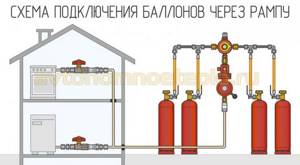
If you connect a gas cylinder to a gas instantaneous or storage water heater according to the scheme described above, replace the jets on the wick and the nozzles on the main burner, adjust the fuel and water supply, you can achieve stable operation of the column after converting to propane.
Floor-standing
With an internal tank volume of 200 liters or more, the device is floor-mounted, since the load on the wall may be excessive. Gas floor-mounted storage water heaters are located in a special technical room, operate fully automatically and do not require frequent maintenance. Built-in safety systems protect equipment from overheating, loss of traction and other unpleasant situations.
It is worth noting. That gas equipment always carries danger, so when choosing, you should pay attention to recognized manufacturers. Products from brands such as BAXI, Bradford White and, of course, the founder of gas equipment for hot water supply, the German company VAILLANT, will be the best and most reliable choice.
A short overview video about Bradford White water heaters:
If there is no centralized gas supply, you have to heat water and cook food using gas water heaters and stoves that can run on a gas cylinder.
What kind of gas is in the cylinders?
The gas cylinder used to heat water contains gases such as propane and butane. They are by-products of oil, gasoline and gas refining. The cylinders may contain only technical butane or a mixture of butane and propane, which is available in summer and winter.
Compression of these gases converts them into a liquid of a smaller volume (and therefore such a gas is called liquefied), and as the pressure decreases, this liquid begins to turn into a vapor state. Since an increase in temperature causes a strong expansion of liquefied gases, the cylinder is usually filled to 85% of its volume, so there is always a layer of vapor gas above the liquid gases.
How do they work?
The device is connected to a propane-butane cylinder. The process of heating water begins from the moment the tap is opened at the water intake point. Heating occurs when the liquid flows through a metal heat exchanger - copper or steel. The heat exchanger itself is heated by the operating burner. Heated water flows to the water intake, and a hot stream flows from the open tap. How stable the water temperature is depends on the characteristics of the water heater - power and performance.
More details on the page “Can a gas water heater be powered by a gas cylinder?”

Connection to a liquefied gas cylinder
First of all, you need to make sure that your gas water heater is configured to use the gas that is present in the cylinder. If required, work is carried out to re-adjust the column by replacing the collector nozzles and assessing the tightness of the connections. In this case, the equipment must be marked with the date of reconfiguration and the type of gas that can be used in the device.
The cylinder that will be connected to the gas water heater must be equipped with a reducer with a stabilization pressure of 300 mm water column, as well as a minimum vapor phase capacity of 1 m³ per hour. They also pay attention to the selection of the hose - its length should be up to two and a half meters, and the internal diameter should be from 12 millimeters. It is important to purchase a hose that can withstand working with a dispenser on a gas cylinder.
When installing the hose, do not bend or twist it. If the hose has to be installed with a bend, adapters are used for this and the radius of the bend is monitored (it should not be less than 90 mm along its outer line). In addition, the hose must not bend within 50 mm of the ends of the nozzles.
The installation of a gas shut-off valve must be carried out in front of the column so that this valve can be easily reached. After completion of installation work, the hose and other connections should be checked to ensure that leaks are detected in a timely manner. Only after this can the column be used to heat water.
Selection options
Once you have understood for yourself which gas water heater to choose based on its operating principle, it’s time to understand the important technical characteristics.
Power
The power indicator affects how quickly a certain volume of water will heat up. But it also affects gas consumption, and in the case of energy-dependent models, also electricity consumption. Therefore, the power should be optimal for specific conditions, and not underestimated or overestimated.
All equipment is divided into 3 categories:
- low power - here the values will be from 17 to 19 kW;
- medium - range from 22 to 24 kW;
- high - power reaches 28-31 kW.
For a family of 3-4 people, medium-power equipment is suitable. If you need to choose a gas water heater for an apartment where a family of 1-2 people lives, then 17-19 kW will be just right. The best geyser for a private house with a large area and a large number of water intake points is 28-31 kW.
Type of burner
Which gas water heater is the most reliable, based on the type of burner? Let's consider both available options, their pros and cons:
- Constant power. This is a standard scheme that was present in the very first models of gas water heaters until the development of modern systems. A constant power burner is characterized by inconsistent water pressure, requires manual adjustment, affects higher gas consumption, and it is not always convenient to set the desired water temperature.
- Modulating. An excellent option, since it assumes several burner operating modes, which change automatically, based on the water pressure and its flow from different water intake points. Stability of pressure, temperature, and the absence of additional actions for the operation of the system are the undoubted advantages of modulating models. But their price, naturally, is somewhat higher.
Heat exchanger
The gas burner heat exchanger is one of the main working units of the system. Therefore, its device must be of high quality and reliable. The following materials are mainly used today:
- Copper. Expensive water heaters are equipped with heat exchangers made of copper, which does not corrode, has high heat transfer, and is durable. The only negative is the price and heavy weight.
- Steel. The best option based on the criteria of durability, cost, anti-corrosion properties and strength. Of course, in general its characteristics are somewhat inferior to copper, but for many this is not critical. The main thing is that the manufacturer you choose does not skimp on the manufacture of the heat exchanger and that its design has a good alloy base and thick walls.
Safety
Gas water heaters have the following elements in the device:
- Traction sensor;
- Temperature control sensor;
- Flame sensor;
- Gas sensor;
- Overheating protection system.
